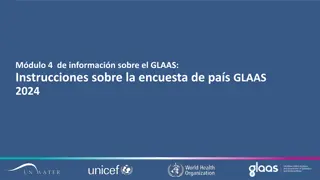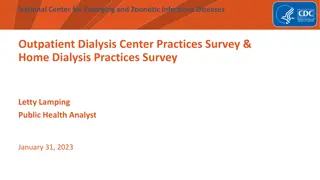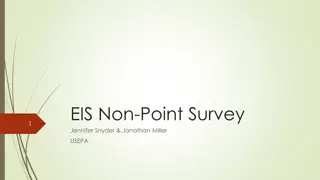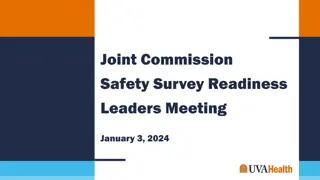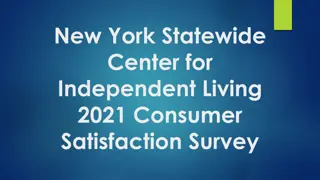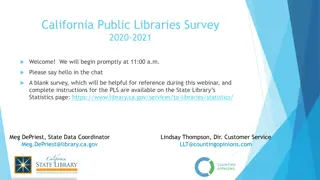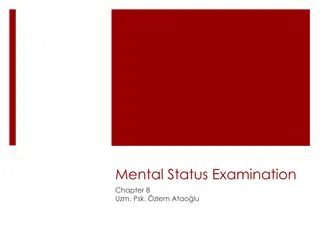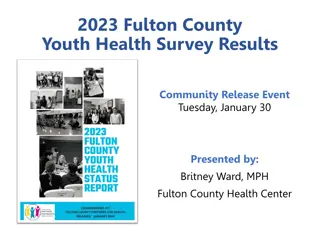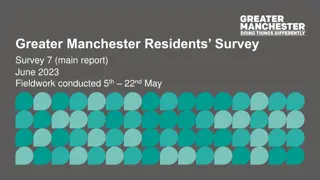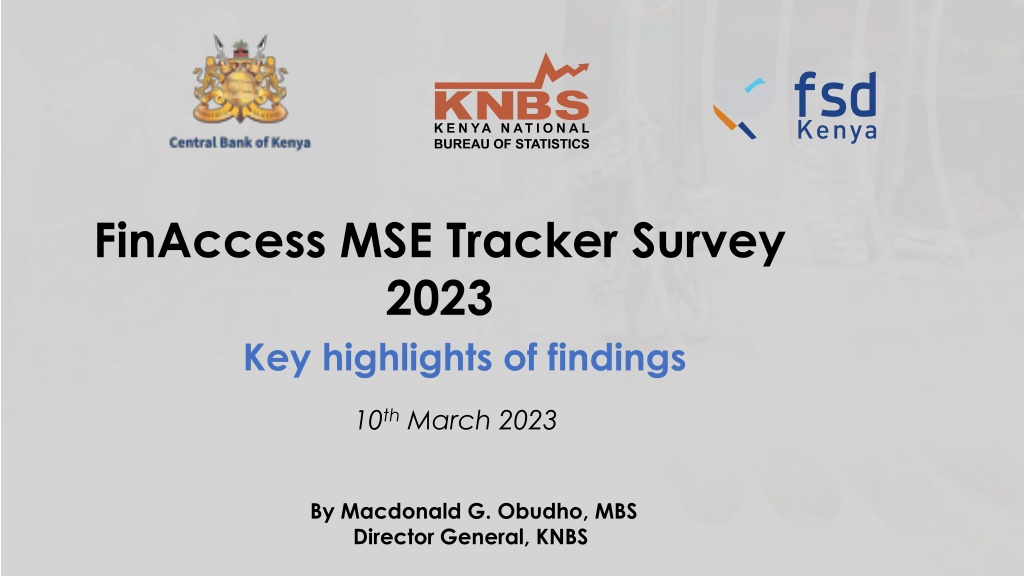
Key Findings from FinAccess MSE Tracker Survey 2023
Gain insights into the key findings of the 2023 FinAccess MSE Tracker Survey, which provides a detailed analysis of micro and small enterprises in Kenya. Explore data on sectors, ownership, turnover, and more, shedding light on the dynamics of the country's financial landscape.
Uploaded on | 0 Views
Download Presentation

Please find below an Image/Link to download the presentation.
The content on the website is provided AS IS for your information and personal use only. It may not be sold, licensed, or shared on other websites without obtaining consent from the author. Download presentation by click this link. If you encounter any issues during the download, it is possible that the publisher has removed the file from their server.
E N D
Presentation Transcript
FinAccess MSE Tracker Survey 2023 Key highlights of findings 10th March 2023 By Macdonald G. Obudho, MBS Director General, KNBS
Outline 1. Background to MSEs survey 2. Survey methodology 3. Findings 4. Conclusion
Background to FinAccess Tracker Surveys FinAccess Surveys Survey monitors developments and progress in the financial sector to gain a better understanding of the inclusivity and overall dynamics of Kenya s financial landscape. FinAccess Household sample surveys - 2006, 2009, 2013, 2016, 2019 and in 2021. Focus on four dimensions namely; Access, Usage, Quality, Impact Why MSE Tracker Surveys? FinAccess provides a rich sample for understanding micro businesses filling information gaps that most studies are unable to capture, because of the nature of these MSEs Track and assess policy impact; (MSE COVID-19 tracker survey) Inform targeted service and product delivery for MSEs sector MSEs Tracker Surveys - a deep-dive to livelihoods approach to inclusive finance - focus on individuals whose main source of income is own business/self employment.
MSEs Tracker Methodology Survey sample Findings based on 2,394 respondents drawn from FinAccess 2019 and FinAccess 2021 surveys that met the following criteria; a) Main source of income is own business/self employment b) Consented to follow-up surveys during the main FinAccess survey c) Provided an active telephone number, and successfully connected(network) d) Completed telephone interview Therefore, survey sampling is non-probability based on: respondents availability, willingness to participate, and accessibility via mobile phone provided. Data collection Data collected between October November, 2022 Telephone interviews - Computer Assisted Telephone Interview(CATI).
Findings - Profile of MSEs that Participated in the Survey Sectors mainly in wholesale and retail trade(63.1) and agriculture based business activities (8.9%). Majority (70%) of MSEs are owner operated (no employees). Women constitute 60.2% of respondents (MSEs) in the survey
Profile of MSEs that Participated in the Survey MSEs monthly turnover Findings on indicate that 11% of MSEs in the survey had a monthly turnover of less than KSh 10,000. At least half of sample reported monthly turnover below KSh 50,000. Higher monthly turnover (KSh 50,000 and above) was reported by MSEs in commercial premises/exhibitions (60%) and those operating at home/online/own residence (57%)
Access to Loans Mobile banking loans emerged as the dominant source of credit by MSEs, at 57.2 percent from 45 percent in 2020 (MSE COVID-19 tracker) Borrowing from informal sources ( Chamas/groups and family/friends) was found to be high among MSEs) In addition to loans, 36.7% of MSEs depend on trade credit from suppliers
Loan default, and sources of money to repay loans Most MSEs use savings, cut expenses on household expenditures, and borrow to repay loans Percentage Borrowers who reported loan defaults by source of loan (default means Missed/delayed a payment, Never paid loan or Paid late) More than half (53.6%) of MSEs borrow to repay loans Other sources of money to repay loans (excluding income from business) Loan from friends/family/neig 48.1 29.1 MFI loan Loan from Chama/group 30.3 28.0 SACCO loan 37.0 Mobile banking loan 33.3 Business Loan-bank 34.0 Personal Loan-bank
Reasons for taking loans The top reasons for taking loans is to purchase stock, run the business, and repay other loans. Total Total Female Female Male Male 54.9 To purchase stock/supplies 46.6 51.6 To cover other business expenses 37.5 37.6 37.5 To pay back other loans/credit 22.1 25.4 23.4 To pay wages/salaries 13.4 19.3 15.8 Personal/Non-business use 15.0 15.3 15.1 Expand business 6.2 2.6 4.8 To pay business rent 2.3 1.3 1.9 Percent Percent Percent
Digitization of customer payments MSEs (%) that have digitized customers payments Digital payments: mobile money(send money/paybill/buy goods), Digital record keeping for business facilitates access to credit. 44.1 percent of MSEs had use a digital payment for payment of goods and services by customers. Use is higher for male MSE owners(47%) compared to females(42%)
Consumer credit provided by MSEs The survey sought to assess the value of the outstanding consumer credit advanced by the MSEs to their customers. Overall, among the 71% of MSEs that provide consumer credit, 38.3 percent of MSEs were owed consumer credit valued at KSh 1,001 - KSh 10,000 Outstanding consumer credit(in KSh) advanced by MSEs
Challenges in accessing supplies The most cited challenge in accessing supplies is increased product prices (64 % of all MSEs) and supply chain constraints(15.6%) Other challenges faced by MSEs are highlighted in report. Challenges
Training and interventions MSEs need . Skills gap exists for business owners in MSEs 31.7% of owners of MSEs have received training in their areas. Infrastructure (25.4%) and training (20.3%) were the most cited support required from Government Types of Non-financial assistance required by MSEs(%) from Government Proportion of business owners(%) trained in their area of business
Closed businesses open in 2021, but closed in Nov 2022 Main reasons for business closure Lack of working capital and customer demand are cited as main reasons for business closure by 42% and 21.2% of MSEs, respectively. More women entreprenuers closed their businesses due to illness(10.7) compared to men (5.5).
Closed businesses More than 50% of business owners that had closed businesses reported that they require capital of KSh 20,000 and above to reopen Findings indicate that 39.7% of business owners that closed tried to get working capital before closing. Percentage Businesses that tried to source for working capital before closing Percentage of MSEs by amount (KSh) required to reopen closed business
Conclusion Findings highlight financial inclusion gaps and challenges across various MSEs segments. Results will inform future monitoring of policies, programmes, product development and actions that address infrastructural, supply chain issues by MSEs. Looking forward, in the next waves, we should be able to track the impact of the new innovations such as the financial inclusion fund (Hustlers Fund).
Thank you Detailed findings in full report accessible in KNBS, CBK and FSD-K websites.


